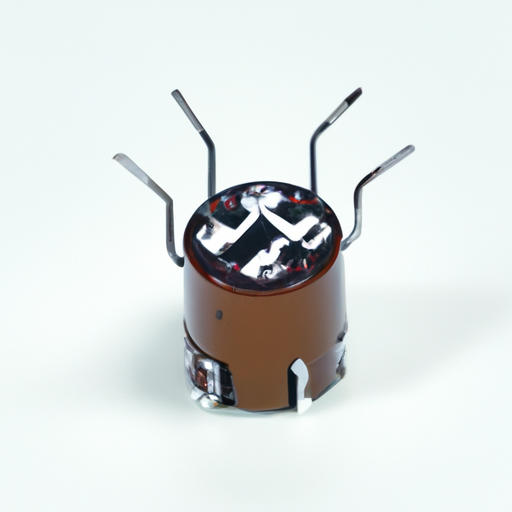Product Characteristics of Fan Capacitors

I. Introduction
A. Definition of Fan Capacitors
Fan capacitors are electrical components that store and release electrical energy to assist in the operation of electric motors, particularly in fans. They play a crucial role in starting and running the motor efficiently, ensuring optimal performance and longevity.
B. Importance of Fan Capacitors in Electrical Systems
In electrical systems, fan capacitors are vital for enhancing the efficiency of motors. They help in improving the power factor, reducing energy consumption, and ensuring smooth operation. Without the appropriate capacitor, a fan motor may struggle to start or run, leading to increased wear and potential failure.
C. Purpose of the Article
This article aims to provide a comprehensive overview of fan capacitors, detailing their characteristics, types, selection criteria, and maintenance. Understanding these aspects is essential for anyone involved in the design, installation, or maintenance of fan systems.
II. Overview of Fan Capacitors
A. What are Fan Capacitors?
1. Functionality
Fan capacitors work by creating a phase shift in the electrical current supplied to the motor. This phase shift is crucial for starting the motor and maintaining its operation. By providing the necessary torque, capacitors enable the motor to overcome inertia and begin spinning.
2. Types of Fan Capacitors
There are primarily three types of fan capacitors: start capacitors, run capacitors, and dual capacitors. Each type serves a specific function in the operation of fan motors.
B. Common Applications
1. Ceiling Fans
In ceiling fans, capacitors are used to start the motor and maintain its operation at various speeds. They ensure that the fan runs smoothly and efficiently.
2. HVAC Systems
In heating, ventilation, and air conditioning (HVAC) systems, fan capacitors are essential for the operation of blower motors, which circulate air throughout the system.
3. Industrial Fans
Industrial fans, used in various applications such as cooling and ventilation, also rely on capacitors to ensure efficient motor operation.
III. Key Product Characteristics
A. Electrical Specifications
1. Capacitance Value
The capacitance value, measured in microfarads (µF), indicates the amount of electrical charge the capacitor can store. This value is critical for ensuring that the motor receives the correct amount of energy to start and run effectively.
2. Voltage Rating
The voltage rating specifies the maximum voltage the capacitor can handle without failing. It is essential to choose a capacitor with a voltage rating that exceeds the operating voltage of the fan motor to ensure safety and reliability.
3. Frequency Rating
The frequency rating indicates the range of frequencies at which the capacitor can operate effectively. This is particularly important in applications where the power supply frequency may vary.
B. Physical Characteristics
1. Size and Form Factor
Fan capacitors come in various sizes and form factors, which can affect their installation and compatibility with different fan models. The physical dimensions must be considered during selection to ensure proper fit.
2. Mounting Options
Capacitors can be mounted in different ways, including bracket mounting or direct mounting on the motor. The mounting option should be compatible with the fan design to facilitate easy installation.
3. Material Composition
The materials used in the construction of fan capacitors can affect their performance and durability. Common materials include aluminum, polypropylene, and polyester, each offering different benefits in terms of heat resistance and longevity.
C. Performance Characteristics
1. Efficiency
The efficiency of a fan capacitor is crucial for minimizing energy consumption. High-efficiency capacitors can significantly reduce the overall energy costs associated with running fan motors.
2. Temperature Tolerance
Fan capacitors must operate effectively across a range of temperatures. A high temperature tolerance ensures that the capacitor can function in various environments without degrading.
3. Lifespan and Reliability
The lifespan of a fan capacitor is an important consideration, as it affects maintenance schedules and replacement costs. Reliable capacitors are designed to last for many years, reducing the need for frequent replacements.
IV. Types of Fan Capacitors
A. Start Capacitors
1. Function and Characteristics
Start capacitors provide a boost of energy to the motor during startup, allowing it to overcome initial inertia. They are typically larger in capacitance value compared to run capacitors.
2. Typical Applications
Start capacitors are commonly used in applications where motors require a significant amount of torque to start, such as in air conditioning compressors and larger ceiling fans.
B. Run Capacitors
1. Function and Characteristics
Run capacitors are used to maintain the motor's operation once it has started. They provide a continuous supply of energy, ensuring smooth and efficient performance.
2. Typical Applications
Run capacitors are found in a variety of applications, including HVAC systems and smaller ceiling fans, where consistent performance is required.
C. Dual Capacitors
1. Function and Characteristics
Dual capacitors combine the functions of both start and run capacitors in a single unit. They are designed to provide the necessary energy for both starting and running the motor.
2. Typical Applications
Dual capacitors are often used in air conditioning units and other systems where space is limited, allowing for a more compact design.
V. Selection Criteria for Fan Capacitors
A. Application Requirements
1. Load Type
The type of load the fan motor will encounter is a critical factor in selecting the appropriate capacitor. Different loads may require different capacitance values and types of capacitors.
2. Operating Conditions
Consideration of the operating environment, including temperature and humidity, is essential for selecting a capacitor that will perform reliably.
B. Compatibility with Fan Motors
Ensuring compatibility between the capacitor and the fan motor is crucial. This includes matching the capacitance value, voltage rating, and physical dimensions.
C. Regulatory Standards and Certifications
Selecting capacitors that meet industry standards and certifications ensures safety and reliability. Look for capacitors that comply with relevant regulations, such as UL or CE certifications.
VI. Maintenance and Troubleshooting
A. Signs of Capacitor Failure
Common signs of capacitor failure include unusual noises from the fan, reduced performance, or the fan not starting at all. Regular monitoring can help identify these issues early.
B. Maintenance Tips
To prolong the lifespan of fan capacitors, regular inspections and cleaning of the fan and motor components are recommended. Ensuring proper ventilation and avoiding exposure to extreme temperatures can also help.
C. Replacement Considerations
When replacing a fan capacitor, it is essential to choose a capacitor with the same specifications as the original. This includes matching the capacitance value, voltage rating, and physical dimensions.
VII. Conclusion
A. Recap of Key Characteristics
Fan capacitors are essential components in the operation of electric motors, providing the necessary energy for starting and running. Understanding their electrical, physical, and performance characteristics is crucial for selecting the right capacitor for specific applications.
B. Importance of Choosing the Right Fan Capacitor
Choosing the appropriate fan capacitor can significantly impact the efficiency and reliability of fan systems. Proper selection ensures optimal performance and reduces the risk of failure.
C. Future Trends in Fan Capacitor Technology
As technology advances, we can expect to see improvements in capacitor design, including enhanced materials for better performance and longevity. Innovations in energy efficiency will also play a significant role in the development of future fan capacitors.
VIII. References
A. Suggested Reading
- "Capacitors: Principles and Applications" by John Smith
- "Electrical Components for HVAC Systems" by Jane Doe
B. Industry Standards and Guidelines
- Underwriters Laboratories (UL) Standards
- International Electrotechnical Commission (IEC) Guidelines
This comprehensive overview of fan capacitors highlights their importance in electrical systems, detailing their characteristics, types, and selection criteria. Understanding these aspects is essential for ensuring the efficient and reliable operation of fan systems across various applications.
Product Characteristics of Fan Capacitors

I. Introduction
A. Definition of Fan Capacitors
Fan capacitors are electrical components that store and release electrical energy to assist in the operation of electric motors, particularly in fans. They play a crucial role in starting and running the motor efficiently, ensuring optimal performance and longevity.
B. Importance of Fan Capacitors in Electrical Systems
In electrical systems, fan capacitors are vital for enhancing the efficiency of motors. They help in improving the power factor, reducing energy consumption, and ensuring smooth operation. Without the appropriate capacitor, a fan motor may struggle to start or run, leading to increased wear and potential failure.
C. Purpose of the Article
This article aims to provide a comprehensive overview of fan capacitors, detailing their characteristics, types, selection criteria, and maintenance. Understanding these aspects is essential for anyone involved in the design, installation, or maintenance of fan systems.
II. Overview of Fan Capacitors
A. What are Fan Capacitors?
1. Functionality
Fan capacitors work by creating a phase shift in the electrical current supplied to the motor. This phase shift is crucial for starting the motor and maintaining its operation. By providing the necessary torque, capacitors enable the motor to overcome inertia and begin spinning.
2. Types of Fan Capacitors
There are primarily three types of fan capacitors: start capacitors, run capacitors, and dual capacitors. Each type serves a specific function in the operation of fan motors.
B. Common Applications
1. Ceiling Fans
In ceiling fans, capacitors are used to start the motor and maintain its operation at various speeds. They ensure that the fan runs smoothly and efficiently.
2. HVAC Systems
In heating, ventilation, and air conditioning (HVAC) systems, fan capacitors are essential for the operation of blower motors, which circulate air throughout the system.
3. Industrial Fans
Industrial fans, used in various applications such as cooling and ventilation, also rely on capacitors to ensure efficient motor operation.
III. Key Product Characteristics
A. Electrical Specifications
1. Capacitance Value
The capacitance value, measured in microfarads (µF), indicates the amount of electrical charge the capacitor can store. This value is critical for ensuring that the motor receives the correct amount of energy to start and run effectively.
2. Voltage Rating
The voltage rating specifies the maximum voltage the capacitor can handle without failing. It is essential to choose a capacitor with a voltage rating that exceeds the operating voltage of the fan motor to ensure safety and reliability.
3. Frequency Rating
The frequency rating indicates the range of frequencies at which the capacitor can operate effectively. This is particularly important in applications where the power supply frequency may vary.
B. Physical Characteristics
1. Size and Form Factor
Fan capacitors come in various sizes and form factors, which can affect their installation and compatibility with different fan models. The physical dimensions must be considered during selection to ensure proper fit.
2. Mounting Options
Capacitors can be mounted in different ways, including bracket mounting or direct mounting on the motor. The mounting option should be compatible with the fan design to facilitate easy installation.
3. Material Composition
The materials used in the construction of fan capacitors can affect their performance and durability. Common materials include aluminum, polypropylene, and polyester, each offering different benefits in terms of heat resistance and longevity.
C. Performance Characteristics
1. Efficiency
The efficiency of a fan capacitor is crucial for minimizing energy consumption. High-efficiency capacitors can significantly reduce the overall energy costs associated with running fan motors.
2. Temperature Tolerance
Fan capacitors must operate effectively across a range of temperatures. A high temperature tolerance ensures that the capacitor can function in various environments without degrading.
3. Lifespan and Reliability
The lifespan of a fan capacitor is an important consideration, as it affects maintenance schedules and replacement costs. Reliable capacitors are designed to last for many years, reducing the need for frequent replacements.
IV. Types of Fan Capacitors
A. Start Capacitors
1. Function and Characteristics
Start capacitors provide a boost of energy to the motor during startup, allowing it to overcome initial inertia. They are typically larger in capacitance value compared to run capacitors.
2. Typical Applications
Start capacitors are commonly used in applications where motors require a significant amount of torque to start, such as in air conditioning compressors and larger ceiling fans.
B. Run Capacitors
1. Function and Characteristics
Run capacitors are used to maintain the motor's operation once it has started. They provide a continuous supply of energy, ensuring smooth and efficient performance.
2. Typical Applications
Run capacitors are found in a variety of applications, including HVAC systems and smaller ceiling fans, where consistent performance is required.
C. Dual Capacitors
1. Function and Characteristics
Dual capacitors combine the functions of both start and run capacitors in a single unit. They are designed to provide the necessary energy for both starting and running the motor.
2. Typical Applications
Dual capacitors are often used in air conditioning units and other systems where space is limited, allowing for a more compact design.
V. Selection Criteria for Fan Capacitors
A. Application Requirements
1. Load Type
The type of load the fan motor will encounter is a critical factor in selecting the appropriate capacitor. Different loads may require different capacitance values and types of capacitors.
2. Operating Conditions
Consideration of the operating environment, including temperature and humidity, is essential for selecting a capacitor that will perform reliably.
B. Compatibility with Fan Motors
Ensuring compatibility between the capacitor and the fan motor is crucial. This includes matching the capacitance value, voltage rating, and physical dimensions.
C. Regulatory Standards and Certifications
Selecting capacitors that meet industry standards and certifications ensures safety and reliability. Look for capacitors that comply with relevant regulations, such as UL or CE certifications.
VI. Maintenance and Troubleshooting
A. Signs of Capacitor Failure
Common signs of capacitor failure include unusual noises from the fan, reduced performance, or the fan not starting at all. Regular monitoring can help identify these issues early.
B. Maintenance Tips
To prolong the lifespan of fan capacitors, regular inspections and cleaning of the fan and motor components are recommended. Ensuring proper ventilation and avoiding exposure to extreme temperatures can also help.
C. Replacement Considerations
When replacing a fan capacitor, it is essential to choose a capacitor with the same specifications as the original. This includes matching the capacitance value, voltage rating, and physical dimensions.
VII. Conclusion
A. Recap of Key Characteristics
Fan capacitors are essential components in the operation of electric motors, providing the necessary energy for starting and running. Understanding their electrical, physical, and performance characteristics is crucial for selecting the right capacitor for specific applications.
B. Importance of Choosing the Right Fan Capacitor
Choosing the appropriate fan capacitor can significantly impact the efficiency and reliability of fan systems. Proper selection ensures optimal performance and reduces the risk of failure.
C. Future Trends in Fan Capacitor Technology
As technology advances, we can expect to see improvements in capacitor design, including enhanced materials for better performance and longevity. Innovations in energy efficiency will also play a significant role in the development of future fan capacitors.
VIII. References
A. Suggested Reading
- "Capacitors: Principles and Applications" by John Smith
- "Electrical Components for HVAC Systems" by Jane Doe
B. Industry Standards and Guidelines
- Underwriters Laboratories (UL) Standards
- International Electrotechnical Commission (IEC) Guidelines
This comprehensive overview of fan capacitors highlights their importance in electrical systems, detailing their characteristics, types, and selection criteria. Understanding these aspects is essential for ensuring the efficient and reliable operation of fan systems across various applications.













